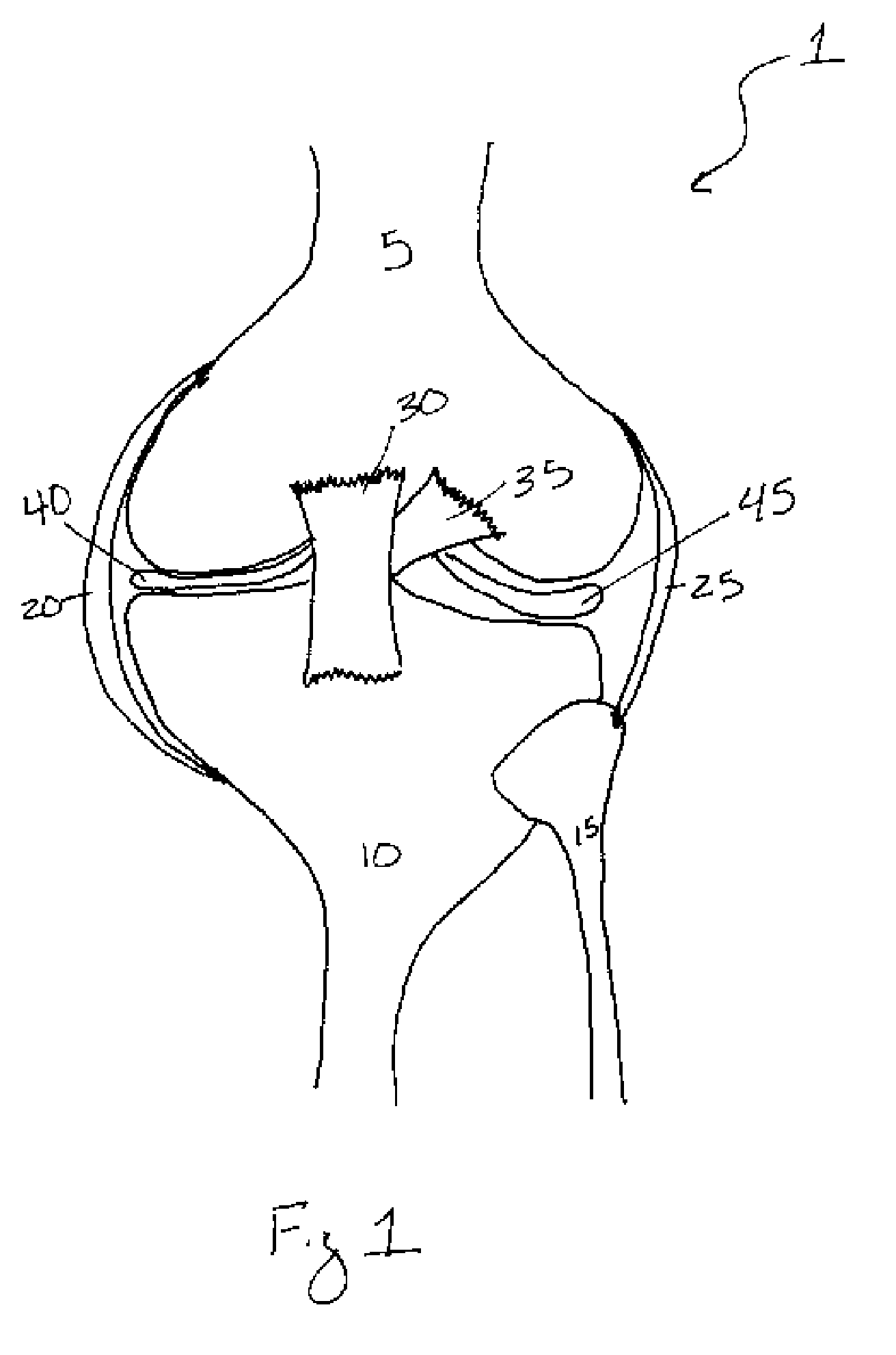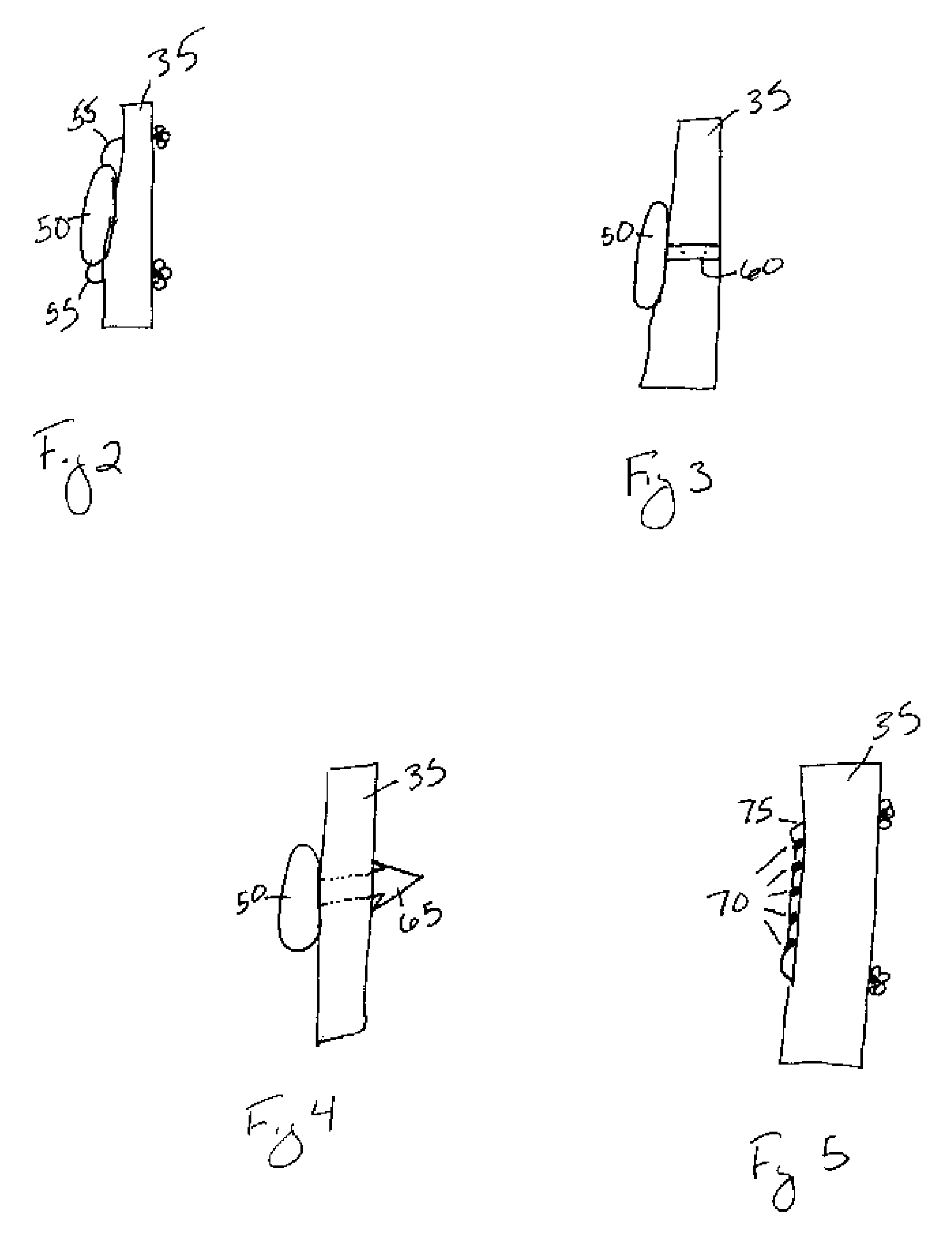Methods of treating a trauma or disorder of the knee joint by local administration and sustained-delivery of a biological agent
a biological agent and knee joint technology, applied in the field of knee joint trauma or disorder treatment, can solve the problems of limited quantity of agents, insufficient methods to serve the needs of patients, and degradation of surrounding tissues and associated chronic pain
- Summary
- Abstract
- Description
- Claims
- Application Information
AI Technical Summary
Benefits of technology
Problems solved by technology
Method used
Image
Examples
first embodiment
[0070]Referring to FIG. 2, in a first embodiment the depot may be comprised of a monolithic or coaxially extruded rod 50. At least one suture 55 may extend from either or both of the ends of the rod 50. The sutures 55 may be comprised of any natural or synthetic, biocompatible and biodegradable polymer, or of any material understood in the art to secure a depot to soft tissue. The suture 55 may also extend from the center of the depot or any location on the depot understood to secure the depot to the soft tissue. In operation, FIGS. 2 and 8 illustrate the product of one method of securing the depot to the ACL 35 by tying the depot to the ACL 35 such that the depot is positioned in the center of the ACL 35 to ensure uniform distribution of the biological agent within the synovial joint. The suture 55 may secure the depot to the ACL 35 by threading the suture(s) through microincisions in the ligament, by tying the suture(s) substantially around the ligament, or any similar method unde...
second embodiment
[0071]Referring to FIG. 3, in a second embodiment the depot may be comprised of a rod 50 with at least one strap or clasp 60 extending from the rod 50. The strap / clasp 60 may be comprised of any natural or synthetic, biocompatible and biodegradable polymer, or of any material understood in the art to secure a depot to soft tissue using a strap / clasp 60. The strap / clasp 60 may extend from the center of the rod 50 or from any location on the rod 50 understood to secure the rod 50 to the soft tissue. In operation, the strap / clasp 60 may be secured to a ligament, such as the ACL 35, within the joint capsule. FIGS. 3 and 8 illustrate the product of one method of securing the depot to the ACL 35 such that the strap / clasp 60 substantially surrounds the ACL 35. Moreover, the depot is positioned in the center of the ACL 35 to ensure uniform distribution of the biological agent within the synovial joint. The rod 50 may also be secured to the ACL 35 distal to the PCL 30, or in any location, su...
third embodiment
[0072]Referring to FIG. 4, in a third embodiment the depot may be comprised of a rod 50 with at least one barb 65 extending from the rod 50. The barb 65 may be comprised of any natural or synthetic, biocompatible and biodegradable polymer, or of any material understood in the art to secure a depot to soft tissue using at least one barb 65. The barb 65 may extend from the center of the rod 50 or from any location on the rod 50 understood to secure the rod 50 to the soft tissue. In operation, the barb 65 is secured to a ligament, such as the ACL 35, within the joint capsule. FIG. 4 illustrates one method of securing the depot to the ACL 35 wherein the barb 65 is threaded through a microincision in the ACL 35. The depot is positioned in the center of the ACL 35 to ensure uniform distribution of the biological agent within the synovial joint. The rod 50 may also be secured to the ACL 35 distal to the PCL 30 or at any location of the ACL 35 so long as the depot does not interfere with th...
PUM
| Property | Measurement | Unit |
|---|---|---|
| diameter | aaaaa | aaaaa |
| diameter | aaaaa | aaaaa |
| molecular mass | aaaaa | aaaaa |
Abstract
Description
Claims
Application Information
 Login to View More
Login to View More - R&D
- Intellectual Property
- Life Sciences
- Materials
- Tech Scout
- Unparalleled Data Quality
- Higher Quality Content
- 60% Fewer Hallucinations
Browse by: Latest US Patents, China's latest patents, Technical Efficacy Thesaurus, Application Domain, Technology Topic, Popular Technical Reports.
© 2025 PatSnap. All rights reserved.Legal|Privacy policy|Modern Slavery Act Transparency Statement|Sitemap|About US| Contact US: help@patsnap.com



